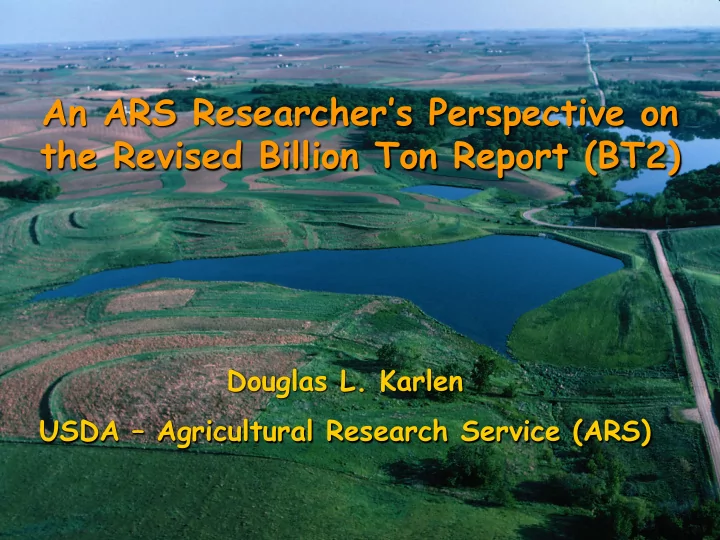

An ARS Researcher’s Perspective on the Revised Billion Ton Report (BT2) Douglas L. Karlen USDA – Agricultural Research Service (ARS)
Sustainable Biofuel is Essential For America’s Energy Future!
The 2005 BTS Identified the Challenge If one ton = 1 sq in Just how much is 1 billion tons = 145 football fields a Billion Tons? A billion ton equals a row of 5 - ft long, 1000 lb round bales that if placed end - to - end would wrap 75 times around the earth
The 2011 BT2 Focused the Challenge By providing: Spatial inventories Price - based supply curves An emphasis on sustainability
BT2 – Involved Many Contributors Oak Ridge National al Lab aborat atory CNJV LLC LLC USD SDA Fore rest Se t Serv rvice ce Robert D. Perlack Bryce J. Stokes Kenneth E. Skog, Craig C. Brandt Patricia K. Lebow Anthony F. Turhollow University o Uni of T Tenne nnessee Dennis P. Dykstra Lynn L. Wright Chad Hellwinckel Marilyn A. Buford Laurence M. Eaton Daniel De La Torre Ugarte Patrick D. Miles Anna M. Shamey Daniel C. Yoder D. Andrew Scott Jacob M. Kavkewitz James P. Lyon James H. Perdue Matt H. Langholtz Timothy G. Rials Robert B. Rummer Mark E. Downing Jamie Barbour Robin L. Graham USD SDA Agri gricu cultu ltura ral R l Research rch John A. Stanturf Serv Se rvice ce David B.McKeever Idaho N o Nation onal Labor orator ory Douglas L. Karlen Ronald S. Zalesny David J. Muth Jane M. F. Johnson Edmund A. Gee J. Richard Hess Robert B. Mitchell Jared M. Abodeely Kenneth P. Vogel USD SDA Nati tional l Insti titu tute te of Food Edward P. Richard and nd A Agriculture Kans nsas S State Uni University John Tatarko P. Daniel Cassidy Richard G. Nelson Larry E. Wagner US USDA Natural Resources State Uni University o of N New Y York University o Uni of M Minne nnesota Cons nservation n Service Timothy A. Volk William Berguson David Lightle Don E. Riemenschneider Thomas S. Buchholz Lawrence P. Abrahamson Uni University o of I Illino nois Texas A&M Uni University Thomas B. Voigt William L. Rooney Iowa Sta State te Univers rsity ty Robert P. Anex
BTS and BT2 Comparisons 2005 Original 2010 Update National estimates – no spatial County - level with aggregation to information state, regional and national levels No cost analyses – just quantities Supply curves by feedstock by county – farmgate/forest landing Crop residue removal sustainability Crop residue removal sustainability addressed from national perspective; modeled at soil – scale; erosion & soil erosion only C No explicit land use change modeling Land use change modeled for energy crops Long - term, inexact time horizon 2010 – 2030 timeline (annual) (2005, ~2025 & 2040) 2005 USDA agricultural baseline and 2010 USDA agricultural baseline 2000 forestry RPA/TPO 2010 FIA inventory and 2007 forestry RPA/TPO Erosion constraints to forest residue Greater erosion plus wetness collection constraints to forest residue collection
BT2 Contributions Better supply estimates for multiple feedstocks Corn grain Corn stover switchgrass Woody Cereal bagasse Energy species straws Cane Greater attention to: Soil carbon issues Harvest strategies Sustainability indicators The residue management tool
Residue Tool Contributions to BT2 Evaluated multiple soil characteristics including organic matter and sand fraction for all relevant agricultural soils (a & b) Calculated available residue (e) from those soils using county level yields and average slope Provided a general guide for available residue, but site - specific slope and yield data (c &d) will provide better guidance for sustainable harvest (f)
BT2 Limitations Continued focus on biomass supply rather than demand No attempt to project demand for bioenergy or bioproducts No attempt to estimate what biomass price might be in an expanded market No estimate of how current biomass uses might be affected at a given biomass price
BT2 is a Positive Step, BUT Not the End !
What’s next? – Landscape Management What is LM? – Recognizing nature’s diversity Why is landscape management important? Diverse landscapes provide multiple ecosystem services Energy efficiency Multiple feedstock sources Enhanced nutrient cycling Multiple C sequestration pathways Food, feed & fiber resources Filtering & buffering processes Wildlife food & habitat Soil protection & enhancement Economic opportunities for humankind
How Can Producers Implement Landscape Management? Assess current practices Erosion Soil, water & air quality Livestock management Identify management options Buffers Waterways Cropping practices Design & implement new strategies Verify responses REAP
What Prevents Landscape Management? Always focusing on individual problems Always seeking a Erosion Water Quality single solutions Bioenergy, air quality, water quality, soil quality, C sequestration, rural Switchgrass Crop Residues development, wildlife habitat, & many other issues must be addressed as an integrated system (e.g. SWAPA+E+H) Fermentation Pyrolysis REAP AP
Any Questions?
Recommend
More recommend